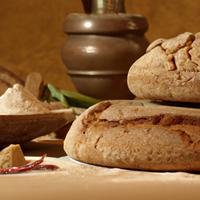
1 serving (43 grams) contains 110 calories, 4.0 grams of protein, 1.5 grams of fat, and 20.0 grams of carbohydrates.

Log this food in SnapCalorie

Nutrition Information
Calories |
305.6 | ||
|---|---|---|---|
% Daily Value* |
|||
| Total Fat | 4.2 g | 5% | |
| Saturated Fat | 0.8 g | 4% | |
| Polyunsaturated Fat | 0 g | ||
| Cholesterol | 0 mg | 0% | |
| Sodium | 472.2 mg | 20% | |
| Total Carbohydrates | 55.6 g | 20% | |
| Dietary Fiber | 8.3 g | 29% | |
| Sugars | 5.6 g | ||
| protein | 11.1 g | 22% | |
| Vitamin D | 0 mcg | 0% | |
| Calcium | 111.1 mg | 8% | |
| Iron | 3.9 mg | 21% | |
| Potassium | 222.2 mg | 4% | |
* Percent Daily Values are based on a 2,000 calorie diet. Your daily values may be higher or lower depending on your calorie needs.
Food Attributes
Source of Calories
About Whole wheat flour bread
Whole wheat flour bread is a wholesome and nutritious option made primarily from whole wheat flour, water, yeast, and a touch of salt. This bread has roots in various cuisines worldwide, most notably European and American traditions, where it’s prized for its hearty texture and earthy flavor. Unlike white bread, it retains the bran and germ of the wheat kernel, making it a fiber-rich choice that supports digestion and provides sustained energy. Whole wheat bread is an excellent source of vitamins such as B vitamins and minerals like iron and magnesium. While it is healthier than its refined counterparts, moderation is key due to its calorie content. Some store-bought versions may contain added sugars or preservatives, so reading labels is important. Ideal for sandwiches or toasting, whole wheat bread is a versatile staple that suits a balanced and health-conscious diet.



